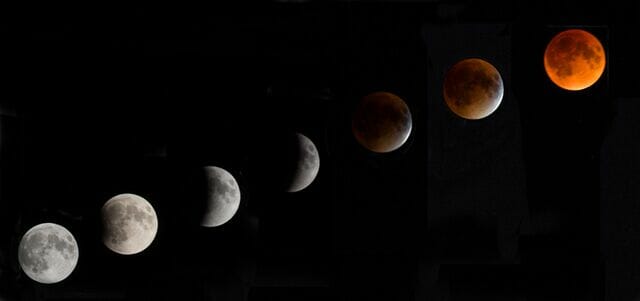
Shooting the Moon…and the Sun and Stars
Shooting the Moon…and the Sun and Stars
Text and Photos by Steve Handley

On September 27, 2015, there was a lunar eclipse that was viewed by probably millions of people fortunate to be under clear skies—and photographed by many. Several members of the Eastman Photography Interest Club, formed in 2014 under the leadership of Fred Orkin were among them.
A lunar eclipse occurs when the moon passes directly behind the earth into its umbra or shadow. This can happen only when the sun, earth and moon align exactly, or closely so, with the earth in the middle. Hence, a lunar eclipse can occur only on the night of a full moon. In the September 2015 event, a total lunar eclipse of a supermoon produced a larger-than-usual blood moon. The photograph above is a compilation of selected images captured over a two-hour period and linked to show the progression of the eclipse until the entire red moon can be seen. I photographed each phase of the moon individually with a 400mm lens coupled with a 1.4x extender.
It is important to photograph during the dark period of night, as well as when there is minimal interference from clouds or city lights. One should use a tripod to steady the camera during time exposures, a good camera that offers a high ISO setting with minimal “noise”, and a lens whose aperture can open widely. In the photograph of the Milky Way shot from Rocky Mountain National Park in Colorado in July 2015, I used a Nikon D810 camera with ISO set at 3200, f-stop at 2.8, and a 14-second exposure. My Nikon 14-24mm was set at 14mm.
In mid-August, from the South Cove boat launch, I attempted to capture the predicted meteor trails. I saw a couple of large flashes overhead, but they disappeared in an instant. The large photo is from that event. Unseen by the naked eye, the camera is able to reveal clouds lit by artificial lights, as well as their reflection on the lake.
I am particularly interested in photographing night sky features such as stars, star trails, and the aurora borealis in addition to the moon, the Milky Way and meteors. It is best to do this either during the night of a new moon, or one to two days before or after, and specifically during astronomical dusk—the time when the geographic center of the sun is at 18 degrees below the horizon. (This data is available on-line.) On average, the darkest night skies fall in the period between two hours after sunset and two hours before sunrise.
Before the rare solar eclipse that will occur in August 2017 and visible here in the U.S., I am planning to photograph some star trails that will involve a series of 30-second exposures spanning 60 minutes or more.
Steve Handley has lived at Eastman for 18 years and contributes frequently to Eastman Living.
Receive your complimentary Relocation guide and magazine


